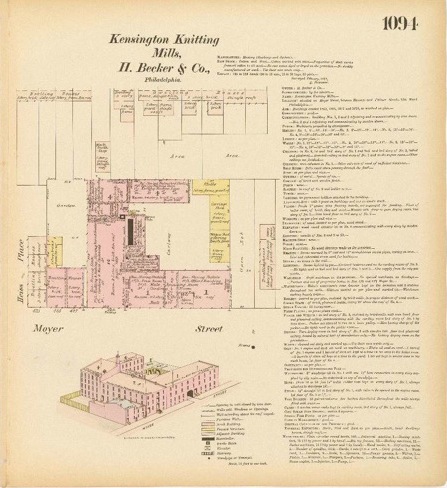
"Keystone Knitting Mills, H. Becker & Co." (1879), Hexamer #1094.
Henry H. Becker Knitting Mill, 1863-1885
425-447 Moyer Street, Philadelphia PA 19125
© Stuart Paul Dixon,
Workshop of the
World (Oliver Evans Press, 1990).
The Henry H. Becker Knitting
Mill with its owner's and manager's houses stands as an
excellent example of the mixed residential and
manufacturing neighborhoods that once dominated Fishtown.
Forming a C-plan at 425-447 Moyer Street, the mill
contains six brick, tin-roofed buildings whose
construction periods range from 1863 to 1885. All the
buildings currently have four stories; the oldest
buildings originally had three stories but were raised a
story in 1879.
The southeast, or front, elevation facing Moyer Street
contains three brick mill buildings that include the
oldest and the youngest structures in the complex. The
four bays at 429-431 Moyer, which date from 1863, have
experienced extensive reworking. 1
An original
hoisting bay extending from the ground level to the upper
story has been replaced with windows. The 10-bay-wide
portion at 433-445 Moyer, where painted brick proclaims
"National Fiberstok Envelope Co.," was constructed in
1871. A door in the west end is a recent addition, while
a loading dock blocks a cartway that once led to an
interior courtyard. An original entrance door
immediately east of the cartway currently contains a
window. The two-bay-wide building at 447 Moyer Street was
constructed in 1885 and has had a window enlarged into a
loading dock. Two four-story buildings parallel to Moyer
Street join the 429-431 Moyer Street mill to the north
and form the upper portion of the C plan. Two other
four-story boiler and engine houses are entered from the
interior courtyard.
The former owner's and manager's houses at 425 and 427
Moyer Street have had modern stone veneer applied to the
first stories. The three-story two-bay-wide dwelling at
425 Moyer has had other extensive modifications. A
two-story brick and frame addition joins the building to
the rear, forming an ell plan. The two-story, two-bay
structure at 427 Moyer is constructed of brick and frame.
Set in the midst of a primarily residential area, the
Becker mill was built in the last half of the nineteenth
century and architecturally portrays the growth of the
textile industry in Philadelphia. Similar to the process
described in Philip Scranton's Proprietary Capitalism,
Henry Becker's enterprise illustrates the accumulation of
capital, entrance into small, often familial,
partnerships, and a resulting increased investment in
physical plant and machinery that allowed textile
craftsmen like Becker, to become factory owners.
2
This kind of
transformation is also revealed in deed transactions and
other city records concerning Becker.
An 1850 street directory lists Becker as a weaver, but in
1855, he is listed as a hosiery manufacturer. In 1857,
Becker purchased two lots along Moyer Street where he
soon built a three-story brick factory, four bays wide.
In 1865, Becker and his partner Justus Koch purchased
five lots contiguous to the factory, and by 1873, they
had constructed two four-story wings connected to the
rear of the original factory, and a three-story, ten-bay
factory parallel to Moyer Street attached to the main
facade. Known as the Kensington Knitting Mills under the
ownership of Henry H. Becker & Co., the factories
produced hosiery and jackets made of cotton worked with
wool. Using one 80 h.p. steam engine Becker ran six wool
cards with 2,240 spindles and four self-actors. Among the
power knitters were 128 circular heads and 16 rib-top
frames, heelers, and sleevers. Power machinery
included 12 jacket and glove frames and 40 sewing
machines. Becker's weekly production consisted of 4,500
dozen hosiery, 200 dozen fancy knit articles, 450 dozen
jackets, and assorted wool and cotton hosiery, fancy
woolens, and wool jackets. 3
According to Proprietary Capitalism, nineteenth-century
manufacturers commonly retired after attaining a
"competency," a tactic Becker used when he sold his
interest in Justus Koch & Co., the successor of Henry
Becker & Co., to his son Henry H. Becker. Directories
of the 1890s list the elder Becker as "gentleman."
In 1907, Henry H. Becker sold the Kensington
Knitting Mills to Henry P. Orlemann, who continued to
produce hosiery until 1912, when the Colonial Preserve
Company converted the mill to a cannery. In 1916,
Colonial Preserve employed 55 men and women in the
manufacture of canned and preserved goods. More recent
owners have been an envelope manufacturer and a chemical
processor.
1 Although Becker
purchased these properties in 1857, Hexamer General
Surveys state that the building was constructed in 1863.
See:
Hexamer General Survey
#565 (1877) "Keystone Knitting Mills, H.
Becker & Co."
Hexamer General Survey
#1094 (1877) "Keystone Knitting Mills, H.
Becker & Co."
Hexamer General Survey
#2066 (1887) "Keystone Knitting Mills,
Justus Koch & Co."
2 Philip
Scranton, Proprietary
Capitalism: The Textile Manufacture at Philadelphia,
1800-1885, (Philadelphia, 1983).
3 Lorin Blodget, Census
of Philadelphia Manufactures (Philadelphia, 1880), pp. 3,
51.
Update May
2007 (by
Torben Jenk):
Demolished.